
linux 内置快捷键

Windows uses the “Windows key” for a lot of useful shortcuts. But if they get in your way—or you’d just like to assign them to different functions—there is a way to disable them all in one fell swoop from the Registry or Group Policy Editor.
Windows使用“ Windows键”获得许多有用的快捷方式。 但是,如果它们妨碍了您的工作,或者您只是想将它们分配给不同的功能,则可以通过注册表或组策略编辑器一次性禁用它们。
It’s important to know that the changes we’re going to talk about in this article are per user, meaning that you’ll have to make these changes for each user account where you want to disable the shortcuts. It’s not hard to do, and we’ll walk you through the whole process.
重要的是要知道我们将在本文中讨论的更改是针对每个用户的,这意味着您必须对要禁用快捷方式的每个用户帐户进行这些更改。 这并不难,我们将引导您完成整个过程。
You should also be aware that these steps only disable the default Windows key shortcuts, not the Windows key itself. You’ll still be able to press the Windows key to open the Start menu. If you’re looking for a way to disable the Windows key entirely, we highly recommend using an app like SharpKeys to turn the key off through the use of key mappings. You can also use it to disable your mostly annoying Caps Lock key while you’re at it.
您还应该知道,这些步骤仅禁用默认的Windows键快捷方式,而不禁用Windows键本身。 您仍然可以按Windows键打开“开始”菜单。 如果您正在寻找一种完全禁用Windows键的方法,强烈建议您使用SharpKeys之类的应用通过键映射来关闭键。 您还可以使用它禁用处于烦人状态的Caps Lock键。
家庭用户:通过编辑注册表来禁用Windows快捷键 (Home Users: Disable the Windows Key Shortcuts by Editing the Registry)
If you have the Windows 7, 8, or 10 Home edition, you will have to edit the Windows Registry to make these changes. You can also do it this way if you have Windows Pro or Enterprise, but just feel more comfortable working in the Registry. (If you have Pro or Enterprise, though, we recommend using the easier Local Group Policy Editor, as described in the next section.)
如果您具有Windows 7、8或10家庭版,则必须编辑Windows注册表才能进行这些更改。 如果您拥有Windows Pro或Enterprise,也可以通过这种方式进行操作,但是在注册表中工作会更自在。 (但是,如果您具有Pro或Enterprise,我们建议使用更简单的“本地组策略编辑器”,如下一节所述。)
Standard warning: Registry Editor is a powerful tool and misusing it can render your system unstable or even inoperable. This is a pretty simple hack and as long as you stick to the instructions, you shouldn’t have any problems. That said, if you’ve never worked with it before, consider reading about how to use the Registry Editor before you get started. And definitely back up the Registry (and your computer!) before making changes.
标准警告:注册表编辑器是一个功能强大的工具,滥用它会使您的系统不稳定甚至无法运行。 这是一个非常简单的技巧,只要您按照说明进行操作,就不会有任何问题。 也就是说,如果您以前从未使用过它,请在开始之前考虑阅读有关如何使用注册表编辑器的信息。 并在进行更改之前一定要备份注册表(和您的计算机!)。
Before you get started editing the Registry, you’ll need to log on as the user you want to make changes for, and then edit the Registry while logged in to their account. If you have multiple users for whom you want to changes for, you’ll have to repeat the process for each user.
在你开始之前编辑注册表,你需要登录作为用户要进行更改,然后编辑注册表,而在自己的帐户登录。 如果您要更改多个用户,则必须为每个用户重复该过程。
After logging on, open the Registry Editor by hitting Start and typing “regedit.” Press Enter to open Registry Editor and give it permission to make changes to your PC.
登录后,通过单击开始并键入“ regedit”打开注册表编辑器。 按Enter键打开注册表编辑器,并授予其对PC进行更改的权限。
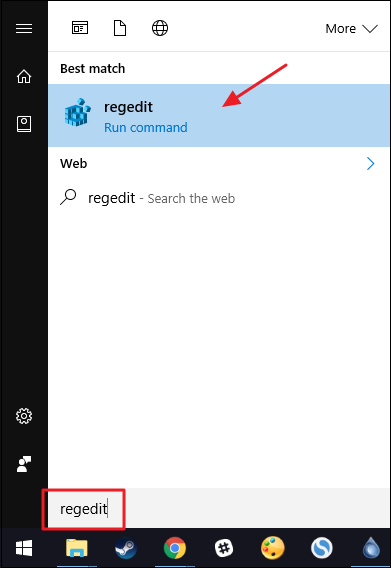
In the Registry Editor, use the left sidebar to navigate to the following key:
在注册表编辑器中,使用左侧边栏导航至以下键:
HKEY_CURRENT_USER\SOFTWARE\Microsoft\Windows\CurrentVersion\Policies\Explorer
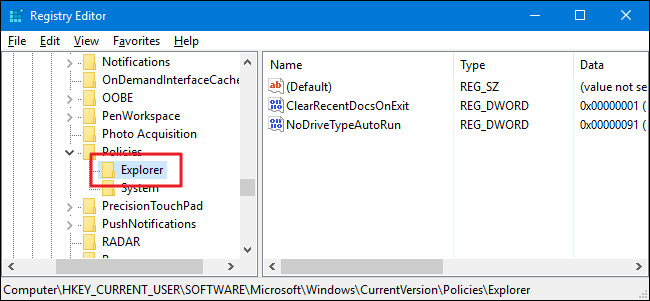
Next, you’ll need to create a new value inside the Explorer key. Right-click the Explorer key and choose New > DWORD (32-bit) Value. Name the new value “NoWinKeys.”
接下来,您需要在Explorer键内创建一个新值。 右键单击Explorer键,然后选择“新建”>“ DWORD(32位)值”。 将新值命名为“ NoWinKeys”。
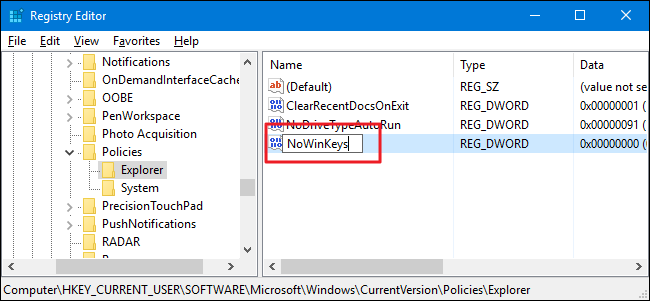
Double-click the new NoWinKeys value to open its properties window. Change the value from 0 to 1 in the “Value data” box and then click “OK.”
双击新的NoWinKeys值以打开其属性窗口。 在“数值数据”框中将值从0更改为1,然后单击“确定”。
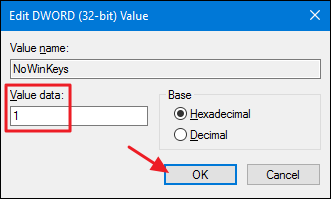
You can now exit Registry Editor. You’ll need to restart Windows (or sign out and back in) for the changes to take place. To reverse the changes, just log on with the account you changed, fire up Registry Editor again, and delete the NoWinKeys value you created. You’ll have to do this for each user for whom you want to restore the Windows key shortcuts.
您现在可以退出注册表编辑器。 您需要重新启动Windows(或注销并重新登录)才能进行更改。 要撤消更改,只需使用您更改的帐户登录,再次启动注册表编辑器,然后删除您创建的NoWinKeys值。 您必须为要为其还原Windows键快捷方式的每个用户执行此操作。
下载我们的一键式注册表黑客 (Download Our One-Click Registry Hack)
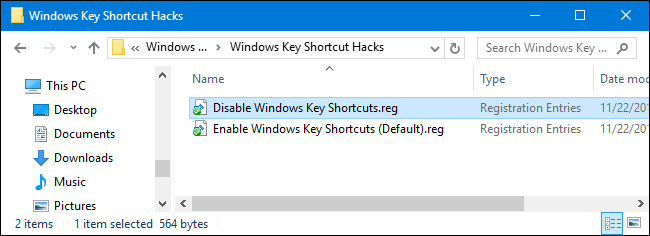
If you don’t feel like diving into the Registry yourself, we’ve created two downloadable registry hacks you can use. One hack disables Windows key shortcuts and the other hack enables them, restoring the default setting. Both hacks are included in the following ZIP file. Double-click the one you want to use and click through the prompts. Just remember that you’ll need to sign in with the user account you want to make the changes for first.
如果您不想自己进入注册表,我们创建了两个可供下载的注册表黑客。 一种hack禁用Windows快捷键,另一种hack启用它们,恢复默认设置。 这两种黑客都包含在以下ZIP文件中。 双击您要使用的一个,然后单击提示。 请记住,您首先需要使用要进行更改的用户帐户登录。
These hacks are really just the Explorer key, stripped down to the NoWinKeys value we described above, and then exported to a .REG file. Running the “Disable Windows Key Shortcuts” hack creates the NoWinKeys value and sets the value to 1 for the currently signed in user. Running the “Enable Windows Key Shortcuts (Default)” hack sets the value back to 0. And if you enjoy fiddling with the Registry, it’s worth taking the time to learn how to make your own Registry hacks.
这些hack实际上只是Explorer密钥,被精简为我们上面描述的NoWinKeys值,然后导出到.REG文件。 运行“禁用Windows快捷键” hack将创建NoWinKeys值,并将当前登录用户的值设置为1。 运行“启用Windows快捷键(默认)” hack会将值重新设置为0。如果您喜欢修改注册表,则值得花时间学习如何进行自己的注册表hack 。
专业版和企业版用户:使用本地组策略编辑器禁用Windows快捷键 (Pro and Enterprise Users: Disable the Windows Key Shortcuts with Local Group Policy Editor)
If you’re using Windows Pro or Enterprise, the easiest way to disable Windows key shortcuts is by using the Local Group Policy Editor. It also gives you a bit more power over which users have this restriction. If you’re turning off the shortcuts for only some user accounts on a PC, you’ll need to do a little extra setup by first creating a policy object for those users. You can read all about that in our guide to applying local Group Policy tweaks to specific users.
如果您使用的是Windows Pro或Enterprise,则禁用Windows快捷键的最简单方法是使用“本地组策略编辑器”。 它还使您可以更灵活地控制哪些用户具有此限制。 如果仅关闭PC上某些用户帐户的快捷方式,则需要先为这些用户创建策略对象,以进行一些额外的设置。 您可以在将本地组策略调整应用于特定用户的指南中阅读所有相关内容。
You should also be aware that group policy is a pretty powerful tool, so it’s worth taking some time to learn what it can do. And if you’re on a company network, do everyone a favor and check with your admin first. If your work computer is part of a domain, it’s also likely that it’s part of a domain group policy that will supersede the local group policy, anyway.
您还应该意识到,组策略是一个非常强大的工具,因此值得花一些时间来学习它可以做什么。 而且,如果您在公司网络中,请给所有人一个帮助,并首先与您的管理员联系。 如果您的工作计算机是域的一部分,则它也很可能是域组策略的一部分,无论如何,该组策略将取代本地组策略。
Start by finding the MSC file you created for controlling policies for those particular users. Double-click to open it and allow it to make changes to your PC. If you just have one user account on your PC, you can open the regular Local Group Policy Editor instead by clicking Start, typing “gpedit.msc,” and then hitting Enter. That’s what we’re going to do in this example, but if you use an MSC file to apply the changes to certain users, the steps are the same.
首先找到您创建的用于控制那些特定用户的策略的MSC文件。 双击打开它,并允许它对您的PC进行更改。 如果您的PC上只有一个用户帐户,则可以通过单击“开始”,键入“ gpedit.msc”,然后按Enter来打开常规的本地组策略编辑器。 这就是我们在此示例中要执行的操作,但是如果您使用MSC文件将更改应用于某些用户,则步骤是相同的。
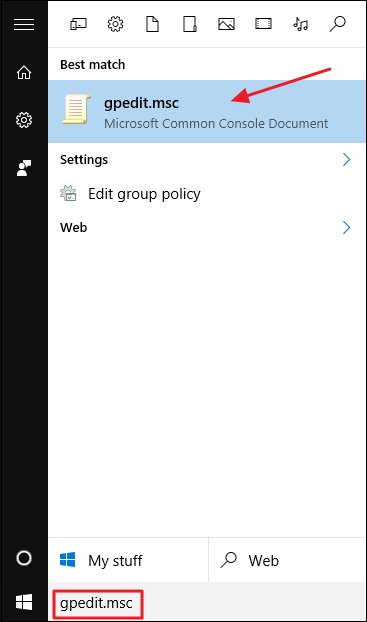
In the Group Policy window for those users, on the left-hand side, drill down to User Configuration > Administrative Templates > Windows Components > File Explorer. If you’re running Windows 7, the “File Explorer” part will be named “Windows Explorer” instead. On the right, find the “Turn off Windows+X hotkeys” setting and double-click it to open its properties window.
在这些用户的“组策略”窗口的左侧,深入到“用户配置”>“管理模板”>“ Windows组件”>“文件资源管理器”。 如果您运行的是Windows 7,则“文件资源管理器”部分将被命名为“ Windows资源管理器”。 在右侧,找到“关闭Windows + X热键”设置,然后双击以打开其属性窗口。
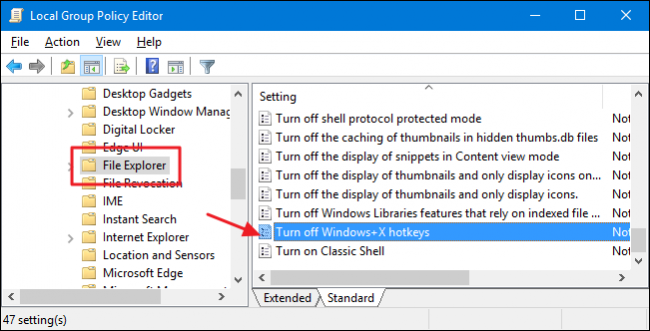
In the setting’s properties window, click the “Enabled” option and then click “OK.”
在设置的属性窗口中,单击“启用”选项,然后单击“确定”。

You can now exit the Local Group Policy Editor. You’ll need to restart the PC (or sign out and back in) for changes to take place. To reverse the change later, just go back to the same “Turn off Windows+X hotkeys” setting and change it back to “Not Configured.”
现在,您可以退出本地组策略编辑器。 您需要重新启动PC(或注销并重新登录)以进行更改。 要稍后撤消更改,只需返回相同的“关闭Windows + X热键”设置,然后将其更改回“未配置”即可。
Image Credit: Maurizio Pesce/Flickr
图片来源: Maurizio Pesce / Flickr
翻译自: https://www.howtogeek.com/282080/how-to-disable-the-built-in-windows-key-shortcuts/
linux 内置快捷键
























 被折叠的 条评论
为什么被折叠?
被折叠的 条评论
为什么被折叠?








